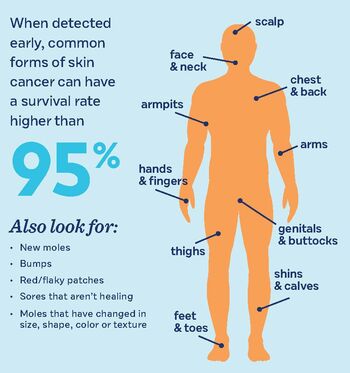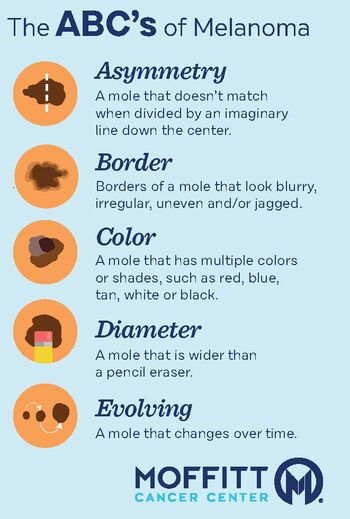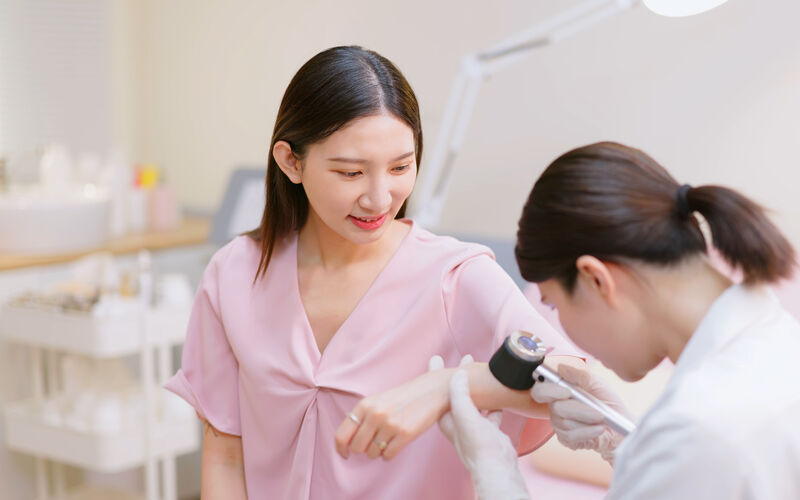Know How to Protect Your Skin This Melanoma Monday
Monday, May 5, marks Melanoma Monday. The first Monday of May is dedicated each year to raising awareness of melanoma and encourages people to pay attention to their skin and ask a dermatologist about areas of concern.
Floridians, especially, should stay vigilant in their fight to protect their skin from the harmful UV rays shining down on us from the sun. And it’s important to remember that melanoma can be avoided with the right planning.
“Sun protection starts with proper clothing: long sleeves and broad-brimmed hats,” said Vernon Sondak, MD, chair of the Cutaneous Oncology Department at Moffitt Cancer Center, adding that simply wearing a baseball cap is not enough. “Wearing sunglasses to protect your eyes and applying sunblock to any exposed skin is also important.”
Sondak and the American Academy of Dermatology both recommend choosing a broad-spectrum sunscreen that protects against ultraviolet A (UVA) and ultraviolet B (UVB) rays, both of which can cause cancer.
 And sunblock isn’t only for those beach, pool or theme park days. Make it part of your everyday routine.
And sunblock isn’t only for those beach, pool or theme park days. Make it part of your everyday routine.
Sondak says the sun’s rays are most direct and intense between 10 a.m. and 2 p.m., so concentrating activities early or late in the day can reduce exposure and decrease the chance of sunburn and long-term risk of skin cancer. While we do need sunlight, we don’t need very much to stay healthy, he adds.
“A few minutes of sun exposure in the early morning or late afternoon will usually result in the maximum amount of endogenous vitamin D your own body can produce, and will do so without leading to tanning or burning, both of which are signs of damage to your skin,” Sondak said. “If you’re worried about getting enough vitamin D, take a multivitamin or vitamin D supplement, don’t spend more time in the sun.”
According to the American Cancer Society, melanoma accounts for only 1% of skin cancers but causes a large majority of skin cancer deaths. The organization estimates 104,960 new melanomas will be diagnosed in the United States in 2025, with a majority of those being found in men. Nearly 8,430 people in the U.S. will die from melanoma this year.
 “Early detection is the best way to maximize your chance of cure from any form of skin cancer,” Sondak said. “Be smart in the sun and pay attention to your skin. If you have a mole that is changing, a sore that isn’t healing or a new lump or bump on or right under your skin, get it checked out right away.”
“Early detection is the best way to maximize your chance of cure from any form of skin cancer,” Sondak said. “Be smart in the sun and pay attention to your skin. If you have a mole that is changing, a sore that isn’t healing or a new lump or bump on or right under your skin, get it checked out right away.”
It’s important to also remember that melanoma doesn’t discriminate. Regardless of ethnicity, skin tone or age, researchers say everyone should protect themselves from the sun’s rays.
In a study published last year in the Journal of the American Association of Dermatology, researchers found that while melanoma is much more common in white individuals, Black men with melanoma are 26% more likely to die from it than their lighter-skinned counterparts.
Sondak says that less heavily pigmented areas on dark-skinned people, such as the soles of the feet, palms of the hands, and underneath toenails and fingernails, are the most common sites of melanoma and other skin cancers.
“We see melanoma arising in those lighter-pigmented areas rather than in other parts of the skin,” he said. “We don’t see many regular skin cancers in African Americans, but we do see it concentrated mostly on the hands and feet. Skin cancer is relatively rare in Black individuals overall so it doesn’t get the attention it should.”
Melanoma remains rare in children and adolescence but often presents in an unusual fashion and often at a more advanced stage than adults. Parents and guardians should encourage regular sunscreen application and other protections on their children.
“While it is rare, children are at risk of melanoma and other skin cancers,” Sondak said. “But each and every one of us needs to be aware of melanoma and other skin cancers, and that’s really what Melanoma Monday is all about.”




